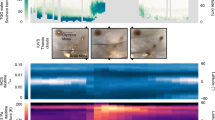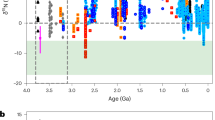Abstract
THE importance of lightning as a source of trace gases in the Earth's atmosphere has long been recognised. In 1827, von Liebig proposed lightning as a source of atmospheric fixed nitrogen1 and recent investigations have supported this hypothesis2–7. In the Earth's pre-biological atmosphere lightning may have produced organic molecules, such as HCN, which led to the evolution of life8. After life evolved, but before photosynthesis and biological nitrogen fixation developed, lightning may have provided an abiotic source of organic C and fixed N to the growing biota9,10. The presence of cloud layers on Venus11 and synoptic scale dust storms on Mars12 suggest that lightning may also occur on these planets, and indeed there have been reports of lightning being detected on Venus by American and Soviet spacecraft. The implications for atmospheric chemistry of lightning on Venus and Mars are discussed here.
This is a preview of subscription content, access via your institution
Access options
Subscribe to this journal
Receive 51 print issues and online access
$199.00 per year
only $3.90 per issue
Buy this article
- Purchase on Springer Link
- Instant access to full article PDF
Prices may be subject to local taxes which are calculated during checkout
Similar content being viewed by others
References
von Liebig, J. Am. Chem. Phys. 35, 329–333 (1827).
Noxon, J. F. Geophys. Res. Lett. 3, 463–465 (1976).
Zipf, E. C. & Dubin, M. Trans. Am. geophys. Un. 57, 965 (1976).
Chameides, W. L., Stedman, D. H., Dickerson, R. R., Rusch, D. W. & Cicerone, R. J. J. atmos. Sci. 34, 143–149 (1977).
Tuck, A. F. Q. J. R. met. Soc. 102, 749–755 (1976).
Griffing, G. W. J. geophys. Res. 82, 943–950 (1977).
Chameides, W. L. Nature 277, 123–125 (1979).
Miller, S. L. & Urey, H. C. Science 130, 245–251 (1959).
Yung, Y. L. & McElroy, M. B. Science 203, 1002–1004 (1979).
Chameides, W. L. and Walker, J. C. G. in preparation.
Knollenberg, R. G., Hansen, J., Ragent, B., Martonchik, J. & Tomasko, M. Space Sci. Rev. 20, 329–354 (1977).
Gierasch, P. J. Rev. Geophys. Space Phys. 13, 790–871 (1975).
Zel'dovitch, Y. B. & Raizer, Y. P. Physics of Shock Waves and High-Temperature Hydrodynamics Phenomena (Academic, New York, 1966).
Stull, D. R. & Prophet, H. JANAF Thermochemical Tables (NSRDS-NBS 37, US Govt. Printing Office, Washington, D.C., 1971).
Seiff, A. et al. Science 203, 787–790 (1979).
Oyami, V. I., Carle, G. C., Woeller, F. & Pollack, J. B. Science 203, 802–805 (1979).
Lin, S. C. J. appl. Phys. 25, 54–57 (1954).
Levine, J. S., Hughes, R. E., Chameides, W. L. & Howell, W. E. Geophys. Res. Lett. 6, 557–559 (1979).
Zucrow, M. I. & Hoffmann, J. D. Gas Dynamics, Vol. 1 (Wiley, New York, 1976).
Uman, M. A. Lightning (McGraw-Hill, New York, 1969).
Baulch, D. L., Drysdale, D. D., Home, D. G. & Lloyd, A. C. Evaluated Kinetic Data for High Temperature Reactions, Vol. 2 (Chemical Rubber Co., Cleveland, 1973).
Hampson, R. F. & Garvin, D. (eds) Chemical Kinetic and Photochemical Data for Modelling Atmospheric Chemistry (NBS Tech. Note 866, NBS, Washington, D.C., 1975).
Sze, N. D. & McElroy, M. B. Planet. Space Sci. 23, 763–786 (1975).
Liu, S. C. & Donahue, T. M. Icarus 24, 148–156 (1975).
Hapke, B. & Nelson, R. J. atmos. Sci. 32, 1212–1218 (1975).
Young, A. T. Icarus 32, 1–26 (1977).
Young, A. T. Geophys. Res. Lett. 6, 49–50 (1979).
Prinn, R. G. Science 182, 1132 (1973).
Wofsy, S. C. & Sze, N. D. Atmospheres of Earth and the Planets, Vol. 51 (ed. McCormac, B. M.) (Reidel, Dordrecht, 1975).
Walker, J. C. G. Evolution of the Atmosphere (Macmillan, New York, 1977).
Seiler, W. Tellus 26, 117–135 (1974).
Taylor, W. L., Scarf, F. L., Russell, C. T. & Brace, L. H. Nature 279, 614–616, 1979.
Ksanfomaliti, L. V. et al. Electrical Discharges in the Venus Atmosphere (D-272, Academy of Sciences, Space Research Institute, Moscow, USSR, 1979).
Author information
Authors and Affiliations
Rights and permissions
About this article
Cite this article
CHAMEIDES, W., WALKER, J. & NAGY, A. Possible chemical impact of planetary lightning in the atmospheres of Venus and Mars. Nature 280, 820–822 (1979). https://doi.org/10.1038/280820a0
Received:
Accepted:
Issue Date:
DOI: https://doi.org/10.1038/280820a0
This article is cited by
-
Charged Particles of Dust, Electrical Discharges, and the Generation of Vortices in Atmospheres of Planets and the Moon
Journal of Russian Laser Research (2019)
-
Estimate of NOX production in the lightning channel based on three-dimensional lightning locating system
Science China Earth Sciences (2014)
-
The Earth's environment?Auniquely stable system?
Geophysical Surveys (1981)
Comments
By submitting a comment you agree to abide by our Terms and Community Guidelines. If you find something abusive or that does not comply with our terms or guidelines please flag it as inappropriate.



